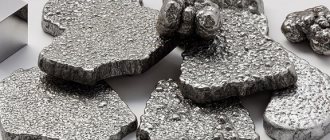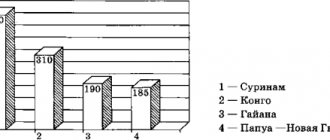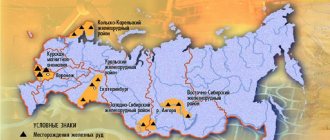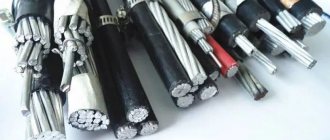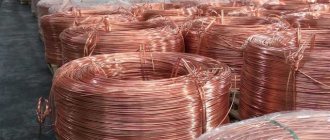Unlike other metals, the history of aluminum does not go back thousands of years. Although aluminum salts were used as far back as ancient Greece and Rome to make paints and treat wounds, it was only in the 19th century that aluminum salts began to be used to a limited extent for the manufacture of small amounts of luxury goods and expensive jewelry.
Aluminum does not have the high attractiveness of gold and silver; it is not used to protect against inflation and deflation. However, aluminum very closely follows the changes that occur in the surrounding life and leading industries, which makes its price movements more predictable than for precious metals.
Below we will look at the features of investing in aluminum abroad.
Primary aluminum
Because aluminum does not exist in nature as a pure element, the aluminum industry cannot simply dig it out of the ground and sell it to end users. Therefore, the basis of the aluminum industry is the extraction of bauxite. Fortunately, bauxite deposits are found in the form of layers near the earth's surface, and therefore bauxite mining is carried out by open-pit mining. The bauxite is then extracted into a white powder known as alumina. To turn alumina into aluminum, it is subjected to intense heat and a large amount of electric current is passed through it. This process is called aluminum electrolysis or aluminum smelting.
The process of extracting bauxite and turning it into aluminum requires large investments of capital, since the construction of aluminum smelting plants requires the expenditure of significant funds. Moreover, smelting aluminum requires a large amount of electrical energy, which is why many aluminum smelters are located either near hydroelectric power plants, or the aluminum producer builds its own power plants to reduce costs.
What is aluminum produced for and where is it used?
Aluminum is a lightweight metal. Aluminum is the most abundant metal in the world. Due to its lightness, strength, functionality and resistance to corrosion, aluminum has become popular and is used in many structures.
If you look closely, you can find aluminum almost anywhere you go. It is used in homes, in transport, in various equipment, including mobile phones and computers, and in other household items - refrigerators, microwaves, furniture and so on.
However, the use of aluminum was minimal a hundred years ago. And 200 years ago they knew little at all about metal. Aluminum occupies about 8% of the entire earth's crust and is the third most abundant element after oxygen and silicon. Despite its prevalence, aluminum is not found in nature in its pure form, which is why it was practically not used for a long time. Aluminum was first produced only in 1824, and only 50 years later it began to be actively used in industry.
Aluminum is three times lighter than iron, but is almost as strong as steel, and in addition is ductile. It is not magnetic and conducts electricity. Capable of forming alloys with almost all other metals.
All these properties have allowed aluminum to become the most popular metal for humans. This metal is used in all modern and high-tech industries - construction, automotive, energy, aviation, food, and space. It is also used in modern electronic technology, shipbuilding and other industries.
The largest aluminum producing companies
Aluminum Corporation of China (Chalco). The world's largest Chinese manufacturer
- bauxite;
- alumina and
- primary aluminum.
The company is also engaged in the production and sale of aluminum alloy products, graphite products and other materials for aluminum electrolysis.
Hongqiao Group. Chinese investment and holding company China Hongqiao Group Limited. The main areas of activity are production and sales:
- molten aluminum alloys
- aluminum alloy ingots
- casting and rolled aluminum products
- aluminum electrical busbars,
as well as exploration and development of bauxite and trade in it, production and sale of electrical energy, provision of leasing financial services.
Rusal. The Russian company Rusal is engaged in the production and sale of primary aluminum and other products related to aluminum smelting, as well as bauxite mining and alumina production. The company has 10 primary aluminum smelting plants, of which nine are located in Russia and one in Sweden. The main activities of the company are:
- mining and processing of bauxite and nepheline ores into alumina
- smelting of primary aluminum from alumina
- processing of aluminum and aluminum alloys into semi-finished and finished products.
Xinfa Group. The company primarily produces and processes primary aluminum and other related products. Xingfa Aluminum is one of the oldest manufacturers of extruded aluminum products in China. This company is a large manufacturer specializing in the production of construction and industrial aluminum profiles.
Rio Tinto. Rio Tinto Aluminum is a division of the multinational mining company Rio Tinto, headquartered in Montreal (Canada). Rio Tinto mines ores and produces metals, including iron ore, aluminum, copper and diamonds, and produces electrical energy. The company has 24 production sites around the world. Aluminum products include ingots for sheet rolling, extrusion ingots, covers and more.
Alcoa. Alcoa is one of the world's leading producers of bauxite, alumina and aluminum products. The headquarters is located in Pittsburgh, Pennsylvania (USA). The company does business and has production facilities in ten countries around the world. Alcoa has the world's largest bauxite mining operations, one of the largest alumina production systems, and a global network of primary aluminum smelters.
Rating of world countries for aluminum production and smelting for 2022
Since 2002, the leader in aluminum smelting in the world has been China . Today China smelts more than half of the world's aluminum production. At the end of 2022, China smelted 36,000 thousand tons , while 64,000 thousand tons of aluminum were produced worldwide. Following China are India and Russia ; they smelt approximately equal amounts of aluminum per year - 3,700 and 3,600 thousand tons, respectively.
For a long time, the United States was the leader in aluminum production in the world, until 2000. Today they are only at the end of the top ten with primary aluminum production at about 1,100 thousand tons. A complete list of countries by primary aluminum smelting can be found in the table below. USGS (United States Geological Survey) data was used as the main source of statistics.
| Rank | A country | Aluminum smelting, thousand tons | Year |
| World | 64000 | 2019 | |
| 1 | China | 36000 | 2019 |
| 2 | India | 3700 | 2019 |
| 3 | Russia | 3600 | 2019 |
| 4 | Canada | 2900 | 2019 |
| 5 | UAE | 2700 | 2019 |
| 6 | Australia | 1600 | 2019 |
| 7 | Bahrain | 1400 | 2019 |
| 8 | Norway | 1300 | 2019 |
| 9 | USA | 1100 | 2019 |
| 10 | Saudi Arabia | 916 | 2017 |
| 11 | Iceland | 870 | 2018 |
| 12 | Malaysia | 760 | 2017 |
| 13 | South Africa | 716 | 2017 |
| 14 | Brazil | 660 | 2018 |
| 15 | Qatar | 650 | 2017 |
| 16 | Mozambique | 577 | 2017 |
| 17 | Germany | 550 | 2017 |
| 18 | Argentina | 433 | 2017 |
| 19 | France | 430 | 2017 |
| 20 | Spain | 360 | 2017 |
| 21 | Iran | 338 | 2017 |
| 22 | New Zealand | 337 | 2017 |
| 23 | Romania | 282 | 2017 |
| 24 | Egypt | 279 | 2017 |
| 25 | Kazakhstan | 256 | 2017 |
| 26 | Oman | 253 | 2017 |
| 27 | Indonesia | 219 | 2017 |
The role of the aluminum industry in the economy
What is the impact of the aluminum industry on the economy? For example, the US aluminum industry annually contributes about $170 billion to the country's economy. This represents about 1% of the annual gross domestic product of the United States. About 160 thousand workers are directly employed in this industry. In addition, each job in the aluminum industry creates at least 3 more jobs in related industries. In total, this represents approximately 700,000 jobs in the production, processing and application of aluminum. These workers bring home more than $40 billion each year, which supports the development of many other sectors of the economy.
Production of aluminum concentrates - aluminum mining
Aluminum fractional concentrate is used for deoxidation of slag in steelmaking (diffuse deoxidation), it is used as a substitute for aluminum shot (granulated aluminum). Concentrates include bauxite that has undergone heat treatment (it takes place at 1200-1400 degrees). They are suitable in metallurgy (production of aluminum from them), or for other purposes, for example, for the production of certain abrasives). Aluminum concentrate can also be called solid slag waste, which is obtained by remelting aluminum alloys and which contains oxides of silicon, calcium, aluminum, metallic aluminum, and also chlorides of alkali metals. The main raw materials from which the final product is extracted are: • Nepheline (up to 25% alumina). Its components are processed, and as a result a concentrate of apatite nepheline is obtained; • Alunite (up to 40% alumina). Complex raw materials, which consist of alkali and sulfuric anhydride; • Bauxite (50% or more); • Cryolite. An artificial compound, the processing process of which is very complex. Aluminum industry in Russia
Three segments of the aluminum industry
The aluminum industry can be divided into three main segments - three streams:
- Upstream: Bauxite mining, alumina production and primary aluminum smelting.
- Midstream: Transformation of primary aluminum into technological semi-finished products for further production of finished aluminum products. For example, rolled aluminum sheets that are sold to automakers.
- Downstream: Production of finished aluminum products, such as aluminum alloys for making car wheels, which are approximately half the weight of steel.
Dynamics of aluminum production by year in the USSR and Russia since 1932
Above I attach a graph with unique statistics on aluminum smelting in the USSR and Russia since 1932. It was in 1932 that aluminum production began in the country. Until now, aluminum was only imported. Imports of aluminum were also high during the Second World War; at that time, our own capacities were still not enough, and aluminum was actively imported from foreign countries, including the USA, Great Britain and Canada. However, aluminum production grew rapidly in the post-war years. By the end of the 1980s, primary aluminum smelting in the USSR reached 3.5 million tons. Like other industries, after the collapse of the USSR, the production of non-ferrous metals in Russia decreased. This happened in the flesh until 1995. Then the smelting of primary aluminum began to grow and by 2004 Russia exceeded the record smelting of the USSR. Despite this achievement, in recent years, aluminum smelting in Russia has begun to decline, reaching its peak in 2008 at 4.19 million tons; smelting at the end of 2022 amounted to only 3.6 million tons.
When drawing up the schedule, data archives from the USGS and the USSR State Statistics Committee were used.
And that’s all for today about aluminum and the lists of countries by smelting and exporting aluminum in the world. Add the article to bookmarks and share with friends. Subscribe to new articles and analytics by e-mail. See you again on the pages of the Tyulyagin !
- 3
Shared
Transport is the driving force of the aluminum industry
There are a large number of end market niches and industries that consume aluminum, including aerospace, automotive, food packaging, and construction.
However, the industry that is really moving the aluminum industry forward today is transport engineering. This industry has become acutely focused on reducing fuel costs and one way to do this is by reducing the weight of vehicles. Since similar aluminum structures are 10-40% lighter than steel ones while maintaining strength, this metal is capable, for example, of reducing fuel consumption by 7-20% while reducing weight by 15%.
Aluminum ores of Russia
The Russian Federation is ranked 7th among all countries in the world in terms of the amount of aluminum ore mined. It is worth noting that this raw material is mined in colossal quantities on the territory of the Russian state. However, the country is experiencing a significant shortage of this metal, and is not able to provide it in the volume necessary to absolutely supply the industry. This is the priority reason why Russia has to purchase aluminum ores from other countries, as well as develop deposits with low quality mineral ores.
There are about 50 deposits in the state, the largest number of which are located in the European part of the state.
However, Radynkskoye is the oldest aluminum ore deposit in Russia. Its location is the Leningrad region. It consists of bauxite, which since ancient times has been the main and irreplaceable material from which aluminum is subsequently produced. Table 1. The largest bauxite deposits in Russia
| Name | Content % | Percentage of total reserves | Degree of industrial development | |
| AL2O3 | SiO2 | |||
| "Little Red Riding Hood" Severouralsk | 53.7 | 3.7 | 3.1 | In developing |
| Kalinskoye, Severouralsk | 56.0 | 2.6 | 3.6 | In developing |
| Cheremuzovskoye, Sverdlosk region | 54.2 | 4.0 | 11.0 | In developing |
| Novo-Kalinskoye, Severouralsk | 55.0 | 3.1 | 7.0 | In developing |
| Iksinskoe, st. Navolok | 53.5 | 17.4 | 11.4 | In developing |
| Vezhayu-Vorykvinskoye. Komi Republic | 49.2 | 0.1 | 11.3 | In preparation |
| Vislovskoye, Belgorod | 49.1 | 7.9 | 12.1 | In reserve |
Automotive industry
Governments around the world are setting increasingly stringent carbon emissions standards for cars. From 2010 to 2020, average carbon dioxide emissions were expected to fall from 142 g/km to 95 g/km, a reduction of 3.9% annually.
Aluminum can reduce the weight of the corresponding part by more than 50% compared to competing materials. For niche models with an all-aluminum body, weight savings reach 30-40%, from 70 to 140 kg, depending on the size of the car.
Major US automakers such as Ford and troublemakers such as Tesla are focusing on using aluminum to reduce the weight of their vehicles to improve performance and safety. The well-known American industry standards CAFE require an increase in mileage per 1 liter of fuel from 2011 to 2025 of at least two times. Therefore, automakers have virtually no choice but to reduce the weight of their cars. Aluminum will play a major role in solving this problem.
Aluminum mining
There are a huge number of minerals in which the presence of this metal was once discovered. Scientists have concluded that this metal can be extracted from more than 250 minerals. However, it is not profitable to extract metal from absolutely all ores, therefore, among all the existing variety, there are the most valuable aluminum ores, from which the metal is obtained. These are: bauxite, nepheline, and alunite. Of all aluminum ores, the maximum aluminum content is found in bauxite. They contain about 50% of aluminum oxides. As a rule, bauxite deposits are located directly on the earth's surface in sufficient quantities.
Bauxite is an opaque rock that is red or gray in color. The strongest bauxite samples on the mineralogical scale are rated at 6 points. They come in different densities from 2900 to 3500 kg/m3, which directly depends on the chemical composition.
Bauxite ores are distinguished by their complex chemical composition, which includes aluminum hydroxides, iron and silicon oxides, as well as from 40% to 60% of alumina, which is the main raw material for the production of aluminum. It is worth saying that the equatorial and tropical zones of the earth are the main areas that are famous for deposits of bauxite ore.
For the nucleation of bauxite, the participation of several components is necessary, including monohydrate alumina hydrate, boehmite, diaspore, as well as various iron hydroxide minerals along with iron oxide. The weathering of acidic, alkaline, and in some cases basic rocks, as well as the slow settling of alumina at the bottom of reservoirs, leads to the formation of bauxite ore.
From two tons of alumina, aluminum turns out to be half as much - 1 ton. And for two tons of alumina it is necessary to extract about 4.5 tons of bauxite. Aluminum can also be obtained from nephelines and alunites.
The former, depending on their grade, can contain from 22% to 25% alumina. While alunites are slightly inferior to bauxites, and consist of 40% aluminum oxide.
Electric cars
Electric cars are currently quite expensive, mainly due to the high cost of batteries. This is why it is important to make electric cars as energy efficient as possible. Reducing weight is one of the most obvious ways to improve the energy efficiency of any car, including electric cars.
The material used to reduce weight is often a little more expensive, heavier classic materials. It has been found that an electric VW Golf car can be made 184 kg lighter if aluminum is used instead of steel. The total cost of an aluminum electric car would be €635 less than a steel electric car.
In addition, life cycle analysis of all-steel and all-aluminum electric vehicles shows that aluminum electric vehicles emit 1.5 tons less greenhouse gases over their life cycle than steel electric vehicles. This life cycle includes production, 150,000 km mileage and disposal.
Aerospace industry
Aluminum is also a very important metal for the aerospace industry. Its ability to make aluminum structures lightweight helps reduce aircraft weight, allowing airlines to save money on jet fuel. Since jet fuel is a major cost factor for airlines, this pushes them to continue to look for ways to reduce the weight of passenger aircraft. This means that it is necessary to continue replacing heavy components with lighter aluminum alloys.
Variety of aluminum products
The main advantages of aluminum are its light weight and ease of processing. Thanks to this, a wide range of different products are made from it. But first, rolled aluminum is produced from aluminum ingots: Rolled sheets. From it, in turn, they make: • Aluminum tires - rectangular (in cross-section) strips, with a thickness of 3 to 12 mm, and a width of 1 to 18 cm. They are sold in coils or strips from 3 to 9 m; • Thick sheet – aluminum plates from 6 mm or more. Most often produced in sizes specified by the customer, and used as blanks (for example, for the production of aircraft wings); • Thin sheet – sheet, thickness from 0.2 to 6 mm. It can be supplied both in sheets and in coils, it can be corrugated aluminum sheet, the so-called “Quintet”, or painted, depending on the wishes of the customer; • Foil – aluminum tape or strip with a thickness of 4 microns to 0.2 mm. Products that are in great demand in the food industry are most often sold in coils, but there are also options in sheets. Long products. This is, first of all: • A round rod of various sections; • Fittings; • Rod square, rectangular, or hexagonal; • Aluminum I-beams, angles, channels; • Wire of various thicknesses; • Ingots, rods or blanks. A rolled profile can be considered a separate aluminum product. Many narrowly targeted products are made from it. Hollow rolled metal. Most often these are aluminum pipes of various shapes and sizes. And although the main shape of aluminum pipe is round, rectangular and square pipes, and sometimes triangular ones, are often found. There are many known cases of manufacturing pipes of more complex shapes (but these are mainly custom-made items).
How to invest in aluminum
Aluminum futures
A futures contract (futures) is a guaranteed trade in the future for a certain number of units of a commodity at some fixed price. This price is called the “strike price” or “delivery price”. Goods are delivered and payment is made on a specific delivery date. For example, on the New York Mercantile Exchange (NYMEX), one futures contract controls about 20 tons of aluminum. Aluminum futures are characterized by high price volatility, which makes trading aluminum futures highly risky.
ETF
The abbreviation ETF stands for Exchange Traded Fund. Such a fund consists of hundreds or even thousands of shares of different companies, collected for some reason. Investing in an ETF is buying a share of a fund that owns assets, such as stocks or commodities. Anyone can buy shares of such a fund.
Trading ETFs has significantly less risk than trading aluminum futures. Some funds offer a combination of several aluminum futures in one exchange-traded note. Others offer a range of aluminum, copper and zinc in one investment basket. There are also ETFs that invest in primary aluminum production around the world.
The most popular ETFs in the aluminum market are [5]:
- iShares Dow Jones US Basic Materials Sector Index Fund (IYM)
- iPath Dow Jones-UBS Aluminum Subindex Total Return ETN (JJU)
Shares of aluminum producers
Investing in aluminum stocks may be more attractive to people who are less risk-averse. After analyzing all the strengths and weaknesses of each investment option, select a company that matches your specific investment plans. The most profitable shares of aluminum industry companies currently include shares of the following companies [6]:
- Century Aluminum Company. A holding company that is a producer of primary aluminum.
- Alcoa Corporation. Produces and sells bauxite, alumina and aluminum products.
- Constellium NV Designs and manufactures aluminum products for various aluminum market segments, including aerospace, automotive and packaging.
- Aluminum Corporation of China Limited. Aluminum producer, including bauxite mining, alumina production and primary aluminum smelting.
- Kaiser Aluminum Corporation. Refers to the processing sector of the aluminum industry. It produces rolled, extruded and cold-drawn semi-finished products for the aerospace, defense, automotive, engineering, electronics and electrical industries.
Dividends
Dividends are payments made by companies to the holders of their shares. Paying dividends is not mandatory, but many companies do so. . Dividends can be paid quarterly, annually or biennially - this depends on the policy of each individual company.
Large corporations with a long history of financial stability and low share price fluctuations are more likely to pay dividends because they have sufficient capital to absorb adverse market fluctuations.
There are joint stock companies, including those in the aluminum industry, that do not pay dividends or pay them very rarely. Often, companies with rising share prices do not pay any dividends and prefer to reinvest profits back into production, hoping that the income from rising share prices will be higher than from paying dividends. This also applies to young companies that do not yet have a recognized, “branded” product and are focused on developing innovative products that may (or may not) be profitable in the future.
Leading countries in aluminum export and import
As I already wrote, aluminum today is used in many industries, in connection with this, not only its smelting is developed, but also trade. Countries around the world actively export and import aluminum for their own needs.
Thus, the largest exporter of aluminum in the world at the beginning of 2022 is Canada . In dollar terms, Canada exported more than $5.3 billion worth of aluminum. Also among the top five largest aluminum exporters in the world are the Netherlands, the UAE, Russia and India. You can see the full list of aluminum export countries
| № | A country | Aluminum exports, million $ |
| 1 | Canada | 5349 |
| 2 | Netherlands | 5115.8 |
| 3 | UAE | 5113.2 |
| 4 | Russia | 4640.9 |
| 5 | India | 3819.7 |
| 6 | Norway | 2802.1 |
| 7 | Australia | 2775.2 |
| 8 | Malaysia | 2003.2 |
| 9 | Bahrain | 1931.5 |
| 10 | Iceland | 1429.3 |
| 11 | Qatar | 1291.6 |
| 12 | China | 1100.5 |
| 13 | USA | 1050.4 |
| 14 | South Africa | 1009.7 |
| 15 | Saudi Arabia | 967.8 |
| 16 | Germany | 957.7 |
| 17 | Mozambique | 940.3 |
| 18 | Italy | 751.1 |
| 19 | New Zealand | 652.9 |
| 20 | France | 578.2 |
| 21 | Spain | 574.9 |
| 22 | Great Britain | 516.6 |
| 23 | Kazakhstan | 513.3 |
| 24 | Poland | 466.6 |
| 25 | South Korea | 445.5 |
| 26 | Slovakia | 385.1 |
| 27 | Slovenia | 372 |
| 28 | Sweden | 362 |
| 29 | Austria | 323.2 |
| 30 | Oman | 296.3 |
| 31 | Romania | 291.9 |
| 32 | Argentina | 264.7 |
| 33 | Luxembourg | 262.7 |
| 34 | Greece | 256.5 |
| 35 | Belgium | 254.1 |
| 36 | Brazil | 236.1 |
| 37 | Vietnam | 231.7 |
| 38 | Türkiye | 219.9 |
| 39 | Egypt | 196 |
| 40 | Singapore | 187.6 |
| 41 | Switzerland | 187 |
| 42 | Taiwan | 185.6 |
| 43 | Chech republic | 176.5 |
| 44 | Tajikistan | 175.2 |
| 45 | Hungary | 137.1 |
| 46 | Bosnia and Herzegovina | 121.1 |
| 47 | Ghana | 106.6 |
| 48 | Cameroon | 100 |
| 49 | Indonesia | 88.7 |
| 50 | Thailand | 88.5 |
| 51 | Azerbaijan | 84.6 |
| 52 | Montenegro | 76.6 |
| 53 | Iran | 76.4 |
| 54 | Japan | 56.6 |
| 55 | Venezuela | 54 |
| 56 | Nigeria | 51.7 |
| 57 | Finland | 31.7 |
| 58 | Albania | 23.4 |
| 59 | Ukraine | 22 |
| 60 | Portugal | 16.5 |
| 61 | Bulgaria | 16 |
| 62 | Serbia | 11.8 |
| 63 | Hong Kong | 11.1 |
| 64 | Ireland | 10.4 |
| 65 | Georgia | 10.3 |
| 66 | Angola | 9 |
| 67 | Iraq | 8.5 |
| 68 | Lebanon | 8 |
| 69 | Estonia | 7.3 |
| 70 | Mongolia | 7.1 |
| 71 | Latvia | 5.7 |
| 72 | Mexico | 5.5 |
| 73 | Syria | 5.3 |
| 74 | Sri Lanka | 5.2 |
| 75 | Jordan | 4.8 |
| 76 | Morocco | 4.2 |
| 77 | Tunisia | 3.9 |
| 78 | Libya | 3.8 |
| 79 | Armenia | 3.4 |
| 80 | Denmark | 2.9 |
| 81 | Kuwait | 2.9 |
| 82 | Croatia | 2.5 |
| 83 | Gabon | 2.3 |
| 84 | Myanmar (Burma) | 2.1 |
| 85 | Cambodia | 2 |
| 86 | Mauritius | 1.8 |
| 87 | Algeria | 1.8 |
| 88 | Pakistan | 1.3 |
| 89 | Kyrgyzstan | 1.2 |
| 90 | Zambia | 1.2 |
| 91 | Colombia | 1.1 |
| 92 | Uzbekistan | 1.1 |
| 93 | Congo | 1 |
| 94 | Afghanistan | 0.9 |
| 95 | North Macedonia | 0.9 |
| 96 | Belarus | 0.8 |
| 97 | Peru | 0.6 |
| 98 | Philippines | 0.4 |
| 99 | Andorra | 0.4 |
| 100 | Tanzania | 0.4 |
| 101 | Lithuania | 0.3 |
| 102 | Equatorial Guinea | 0.3 |
| 103 | Kenya | 0.3 |
| 104 | Yemen | 0.2 |
| 105 | DR Congo | 0.2 |
| 106 | Laos | 0.2 |
| 107 | New Caledonia | 0.2 |
| 108 | Israel | 0.2 |
| 109 | Costa Rica | 0.2 |
| 110 | Virgin Islands | 0.1 |
| 111 | Moldova | 0.1 |
| 112 | Ecuador | 0.1 |
| 113 | Chile | 0.1 |
| 114 | Somalia | 0.1 |
| 115 | Samoa | 0.1 |
The largest importers of aluminum in the world are (the share of world imports is indicated in brackets):
- USA (12.6%)
- Germany (9.1%)
- Japan (4.5%)
- Netherlands (4.5%)
- France (3.9%)
- Mexico (3.9%)
- Italy (3.6%)
- South Korea (3.6%)
- China (3.3%)
- UK (2.9%)
Track and monitor
- Every aluminum investor should constantly monitor new directions and changes in the aluminum industry, as well as the dynamics of the economy as a whole, in order to understand in time when aluminum prices are ready to rise.
- Aluminum stock trading is highly cyclical and commercially more complex than other metals. Therefore, it is necessary to constantly monitor the state of aluminum stock trading and be sure to have a ready-made plan for a quick exit from it in the event of an unfavorable market situation.
Sources: 1. Aluminum Nation – https://www.aluminum.org/ 2. Driving Modern Manufacturing – The Aluminum Association – 2022 3. Aluminum in Cars – Unlocking the Light-Weighting Potential – European Aluminum Association – 20204. How to Invest in Aluminum / Karen Rogers – https://finance.zacks.com/invest-aluminum-5655.html 5. Aluminum: Investing Essentials – An investing primer on the aluminum industry /Matthew DiLallo – https://www.fool.com /investing/general/2014/08/07/aluminum-investing-essentials.aspx 6. List of Aluminum ETFs – https://fknol.com/etf/list/aluminum.php 7. Top Aluminum Stocks With Highest Returns – https http://fknol.com/list/best-performing/aluminum-stocks.php
